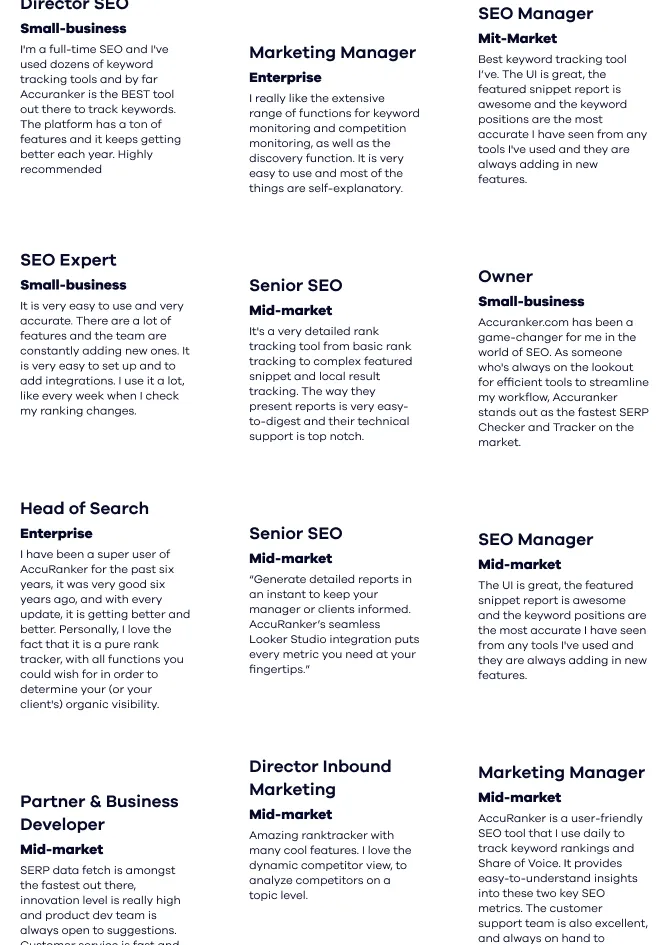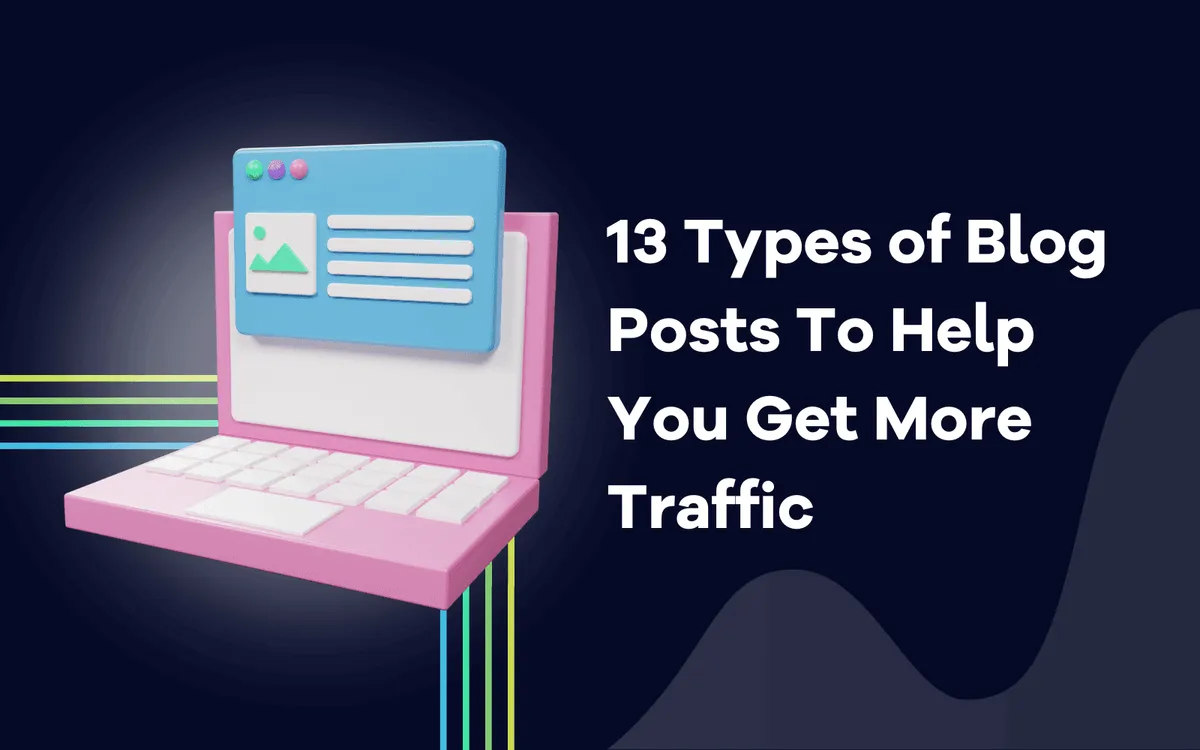
13 Types of Blog Posts To Help You Get More Traffic

Chris Wu
February 3, 2024
Revolutionize your blog! Top-performing types of blog posts to skyrocket traffic. Boost visibility and engagement. Your path to blogging success!
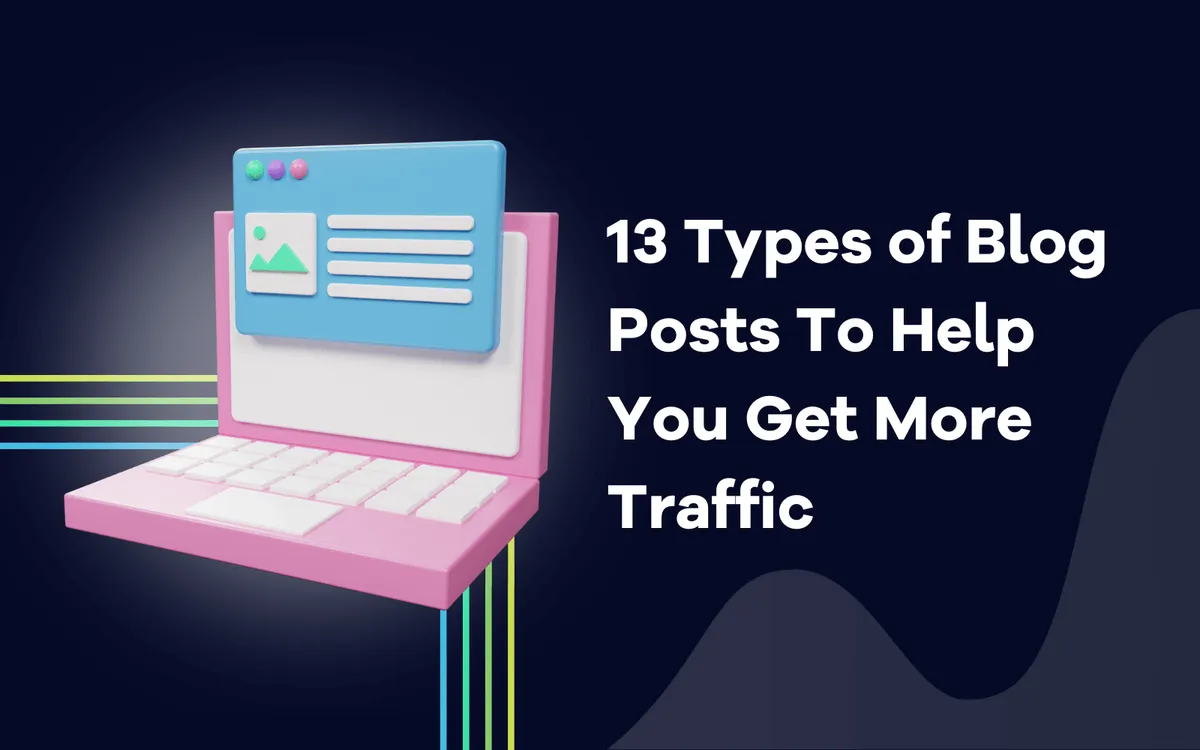
According to an Ahrefs study, 96.55% of blog content gets zero traffic from Google.
This is not a surprise because most bloggers think that posting as frequently as possible is the secret to increasing blog traffic.
However, this leads to publishing content that fails to engage and attract readers.
Having been blogging for over 5 years now, I have found that the secret to increasing blog post traffic is to diversify content.
In fact, throughout my blogging journey, I have experimented with various blog post ideas and found out that some have a great potential to generate more traffic while others don’t.
So in this post, I’m going to share thirteen blog content ideas that are proven to attract more traffic and boost engagement, along with tips for creating them.
Let’s get started.
#1. Listicles/List Posts
These days’ blog readers want to get the information they are looking for as fast as yesterday.
This is where listicles or list posts become handy. I call these types of blog posts “the traffic-magnet masters.”
These bite-sized, numbered pieces of information have become the undisputed kings of content in attracting clicks and traffic. But why? Their secret lies in their simplicity, digestibility, and the promise of quick, actionable insights.
Here is an example of a well-curated listicle/list post:
 Source: Shopify
Source: ShopifyAs you can see, the post contains a numbered list of items with bullets, improving the readability of the content.
Here are tips to create traffic-pulling listicle posts:
Focus on actionable advice
Craft an attention-grabbing title and engaging introduction
Keep the post well-structured and organized
Provide value in each point
#2. How-to Guides/Articles
Your blog readers are using Google to find answers to burning questions they have. They want to learn how to fix, build something, or learn something new.
By creating how-to guides, you can pull massive traffic to your blog. For example: An email marketing guide.
How-to guides or articles, otherwise known as tutorials provide step-by-step instructions to solve a problem or achieve a specific goal.
Readers are drawn to these guides for their actionable insights, clear instructions, and the promise of tangible results.
What sets how-to guides apart is their hands-on, actionable nature. Unlike some content types that may focus on inspiration or entertainment, how-to guides empower readers with the knowledge and skills they need to implement solutions immediately.
This is the key reason why most bloggers are publishing “how-to articles:
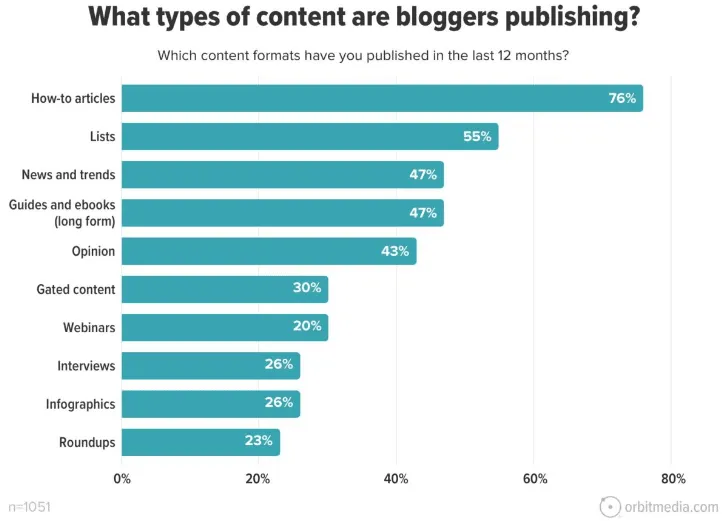
Source: Orbit Media
Here is an example of an in-depth how-to guide: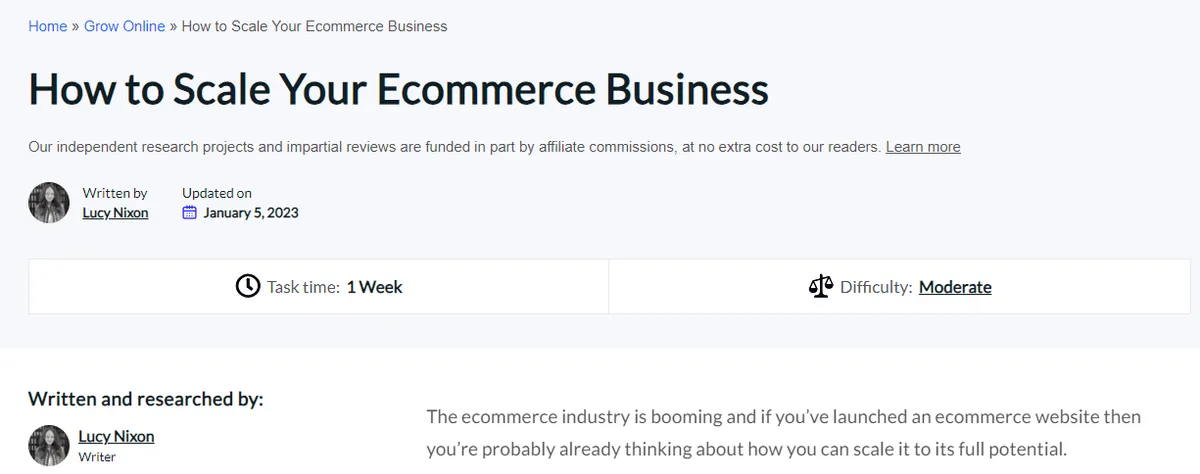
Source: Website Builder Expert
Here are tips to make your “how-to” guides traffic magnets:
Target a specific pain point
Choose a clear and specific topic
Break it down into bite-sized steps
Add visuals and resources
Provide real-life examples
Include CTAs like buttons, text, QR codes, etc.
End your post with a bang
#3. Product Review Posts
According to a recent PowerReviews survey, 99.9% of consumers say they consult reviews when shopping online:

Source: PowerReviews
As consumers increasingly seek trusted opinions before making purchasing decisions online, crafting compelling product review posts has become more crucial than ever.
Product reviews provide valuable insights, build trust, and assist readers in making informed choices. In the blogging space, a well-crafted product review can not only attract traffic but also establish your blog as a reliable source of recommendations.
Here are tips for crafting compelling product reviews:
Ensure you thoroughly understand the product you're reviewing
Choose products with relevance and intrigue
Be transparent and authentic in your review
Capture your readers' attention from the beginning.
Incorporate high-quality images or even videos to enhance your review.
Share your personal experiences with the product
Go beyond the specs
#4. Comparison Posts
Comparison posts are a powerful tool for attracting and guiding your audience towards making a decision.
They serve as decision-making compasses for readers navigating the complexities of choices. Whether evaluating products, tools, or approaches, readers appreciate side-by-side analyses that help them make informed decisions.
These posts provide readers with valuable insights into the similarities and differences between competing products, services, or strategies.
What sets comparison posts apart is their ability to dissect alternatives objectively.
Here is an example of a comparison post: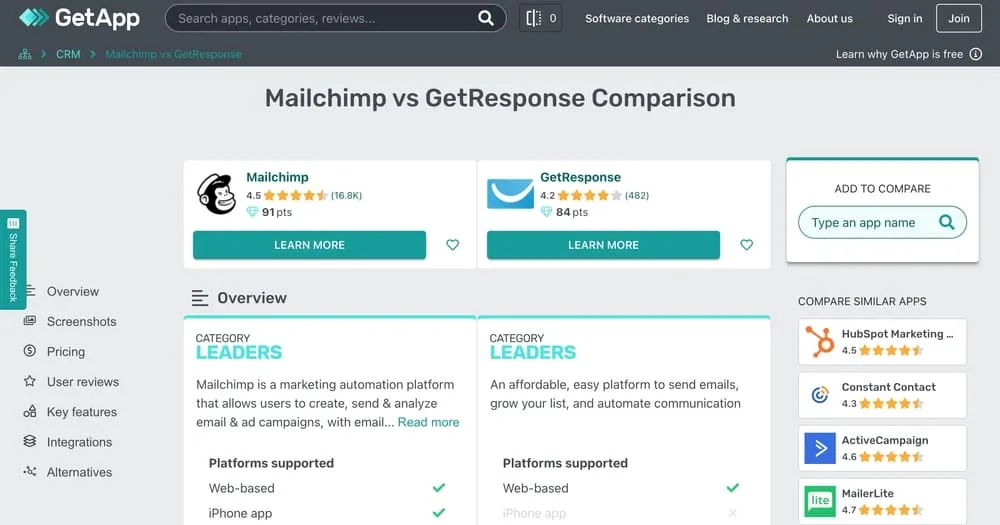
Source: GetAPP
Here are practical tips to create engaging comparison posts:
Choose worthy contenders
Invest time in comprehensive research on each item being compared
Focus on audience needs, not just features
Embrace visuals and interactivity
Incorporate real user experiences
Address potential concerns
Include a clear verdict or recommendation
#5. Case Studies
Case studies are another popular type of blog post that tells real-life stories of success, showcasing how your product or service transformed a business, solved a challenge, and ultimately delivered tangible results.
These posts not only provide valuable insights into the effectiveness of products or strategies but also offer a compelling storytelling avenue.
They offer readers a glimpse into actual experiences and outcomes. They provide a tangible connection to the benefits of a product, service, or strategy, making them a powerful tool for building trust and attracting traffic.
Here is an example of a case study to inspire your creativity:

Source: AccuRanker
Here's how to turn your case studies into traffic-generating machines:
Choose a client with a relatable story
Focus on the journey, not just the destination
Quantify the impact
Offer actionable insights
Enhance your case study with visuals such as images, charts, graphs, or videos. Visual elements break up the text and provide a visual representation of the journey.
#6. Statistics and Data Studies
In today’s data-centric world of blogging, statistics and data studies serve as beacons of credibility and authority. These posts provide evidence-backed insights, establishing trust and authority.
Readers are drawn to the reliability of numerical information, making these posts effective tools for attracting traffic and engaging audiences interested in data-driven content.
What sets statistics and data studies apart is their reliance on empirical evidence.
By presenting findings in a clear, organized manner, these posts provide readers with valuable insights, trends, and patterns derived from real data.
Statistics posts, or “stats pages” as they are sometimes known, tend to receive a great number of referring links, which builds their authority and improves rankings. The reason for this is that other content creators tend to look for these blogs as ways to support the points they are making, and often link to the statistics page in turn. Take for example this blog on “cold calling statistics” which ranks 3rd for that same term, largely due to the 174 individual domains that link to it.
Here is an example of a statistics and data study post:
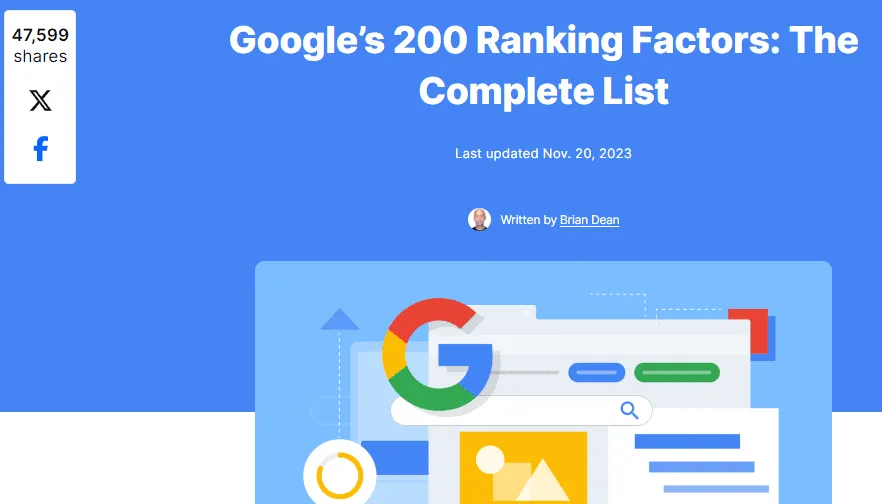
Source: Backlinko
Here are handy tips to turn your statistical studies into traffic-generating gold mines:
Select topics that are relevant to your audience
Ensure the data you use is reliable and comes from credible sources
Enhance the visual appeal of your study by using infographics.
Tie your data analysis to what's happening in the world
#7. News and Events Posts
News and events posts serve as dynamic, real-time content that keeps your audience informed and engaged.
These posts capitalize on the curiosity of the readers’ eagerness to stay abreast of the latest developments.
By providing timely and relevant information, these posts become essential reads, attracting traffic from those seeking the latest insights.
What sets news and events posts apart is their immediacy and relevance. By delivering up-to-the-minute information, these posts create a sense of urgency, encouraging readers to engage promptly.
Here is an example of a news and events post:

Source: Search Engine Journal
Here are useful tips for crafting engaging news and events posts:
Stay timely and relevant
Focus on news and events relevant to your niche
Provide context and background
Quote experts related to the news or event
Consider creating roundup posts summarizing key highlights, insights, or memorable moments
#8. Interviews and Expert Roundups
Sometimes the most valuable insights don't come from your keyboard or Google search but from the minds of others. That's where interviews and expert roundups shine.
Interviews and expert roundups stand as pillars of authority, bringing the voices of industry leaders and experts to your audience.
These posts offer readers exclusive access to the thoughts and experiences of industry experts.
By featuring authoritative voices, they become magnets for traffic, drawing in audiences interested in gaining insights from established professionals.
Here are tips to create interviews and expert roundup posts that generate traffic:
Choose your interviewees or experts wisely
Prepare insightful questions
Don't just present a collection of quotes. Craft a compelling narrative around the interview or expert roundup
Enhance your post with engaging multimedia elements such as images, videos, or audio clips
Include expert quotes
#9. Checklists
In the online world, information overload is a constant threat. Attention spans are shrinking, and readers are hungry for actionable, bite-sized content that gets them to the "do" faster than the "think."
This is where checklists become useful.
These blog post types offer readers actionable and organized content that promises clear steps toward a goal.
They provide a structured and easy-to-follow format, making them incredibly appealing to readers seeking practical guidance.
Here is an example of a checklist post:
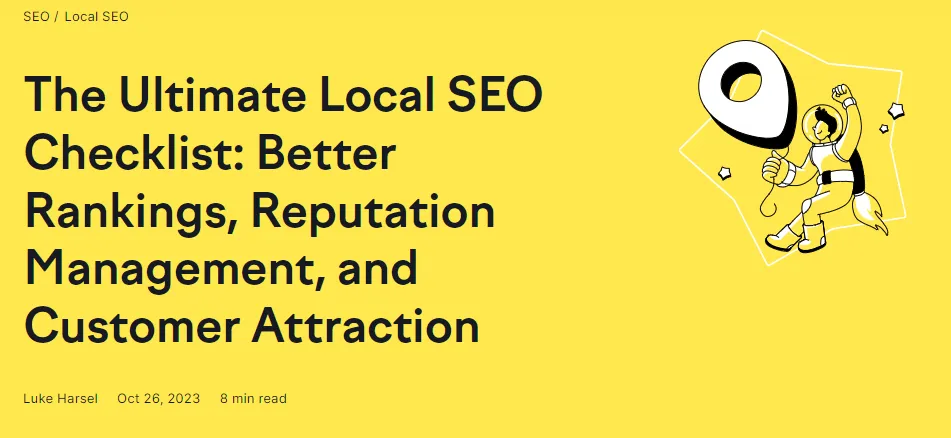 Source: Semrush
Source: SemrushWhat sets checklists apart is their simplicity and effectiveness. They distill complex processes into manageable tasks, offering readers a roadmap to success or achievement.
Here are actionable tips to create a checklist post:
Arrange your checklist in a logical and sequential order
Focus on actionable, achievable tasks
Enhance the checklist with visual elements such as icons, images, or color-coding.
Be concise in your checklist items, focusing on actionable tasks
Offer bonus resources and tips
#10. Content Hubs
Content Hubs are the dynamic libraries of the blogging world, centralizing information on specific topics to provide readers with comprehensive and in-depth resources.
These blog posts put together diverse content formats and resources into one centralized location, offering readers a wealth of information on a specific topic.
This approach not only caters to varied preferences but also becomes a go-to destination for enthusiasts seeking extensive insights.
What sets content hubs apart is their ability to curate and organize a wide range of content types, creating a rich and immersive experience for the audience interested in a particular subject.
Here is an example of a content hub:
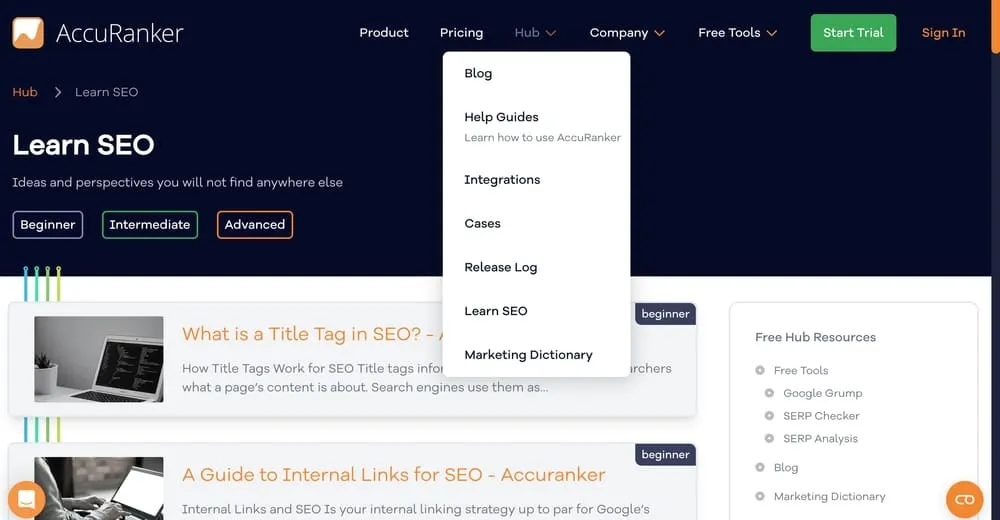
Source: AccuRanker
Here are tips for crafting engaging content hub posts:
Structure your content hub around specific themes or subtopics within the main subject
Diversify your content by including various formats such as articles, videos, infographics, podcasts, and more.
Use categories, tags, and menus to help readers easily navigate through the different sections.
Feature expert contributions
Cross-link and connect
#11. Infographic
In the battle for attention, words can sometimes get lost in the digital battlefield. Enter infographics, the visual warriors of the blogosphere, transforming complex data into eye-catching stories that capture hearts and minds in an instant.
Infographics combine the strength of visuals and concise information, making them highly shareable and easy to digest. Readers are drawn to the engaging format, making infographics effective tools for attracting traffic and conveying key messages.
What sets Infographic posts apart is their ability to present information in a condensed and visually striking format. They cater to readers who prefer a quick and visually engaging overview of a topic.
Here is an example of an infographic post:
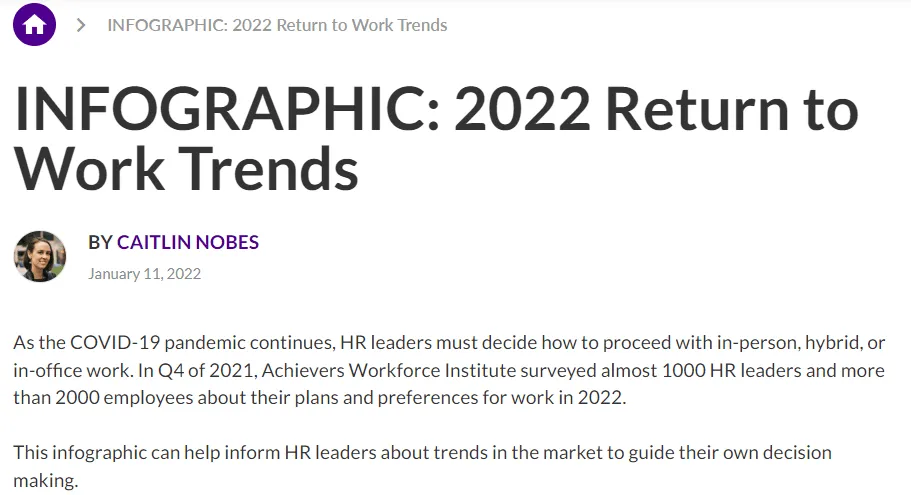
Source: Achievers
Here are tips for creating engaging infographic posts:
Choose a compelling topic that is relevant to your niche
Prioritize clarity and simplicity
Use eye-catching design
Break down complex concepts into simple, digestible elements
Organize your information in a logical flow.
Clearly highlight key takeaways or main points
Incorporate data and statistics
#12. Personal Stories
Personal Stories are the heartbeat of blogging, forging a genuine connection between you and your blog audience.
These types of blog content peel back the curtain on your experiences, challenges, and triumphs, connecting with readers on a deeper level than any statistic ever could.
The authenticity and relatability of personal narratives make them powerful tools for attracting traffic and fostering a sense of community.
Here is an example of a personal story post:

Source: Be More with Less
Here are tips for crafting engaging personal stories:
Choose a story with universal appeal
Be authentic and vulnerable
Inject emotion and sensory details
Include vivid descriptions
Give your story structure, with a clear beginning, middle, and end.
#13. Guest Posts and Collaborations
Guest Posts and Collaborations introduce new voices and insights to your blog, expanding your reach and tapping into the existing audience of your collaborators.
The combined efforts of diverse creators make these posts powerful tools for attracting traffic and fostering a sense of community.
What sets guest posts and collaborations apart is the collaborative nature, allowing for a blend of perspectives and expertise. It's a mutually beneficial strategy that benefits both the host and the contributor.
Here is an example of a guest post by Noah Kagan, the Chief Sumo at AppSumo.
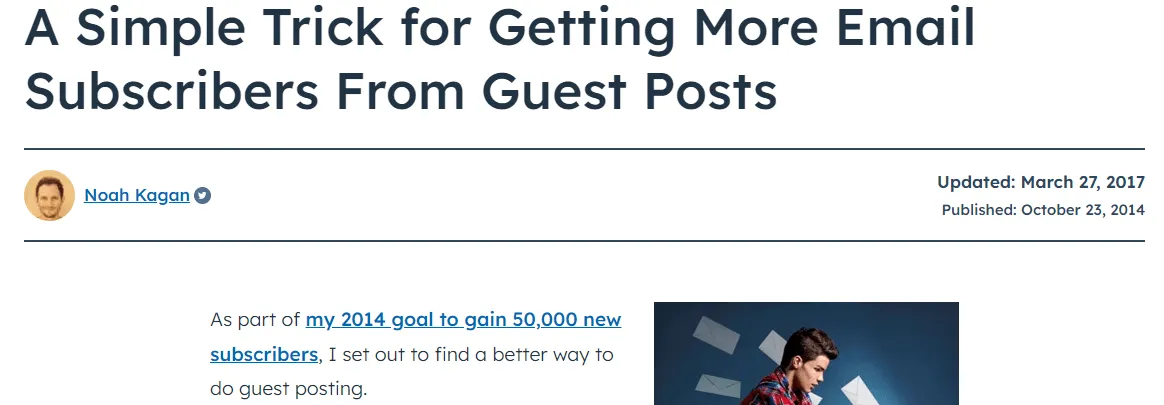
Source: HubSpot
Here are tips for crafting engaging guest posts and collaborations
Identify reputable contributors
Craft unique and valuable content
Don't leave the traffic party at the doorstep. Share your guest post on your platforms, and encourage your partner to do the same
Build long-term relationships
Conclusion
Ready to transform your blog?
There you have it! These types of blog posts are proven to generate more traffic.
Remember, successful blogging isn’t about churning out a daily tsunami of words; it's about crafting strategic content that hooks your audience, resonates deeply, and keeps visitors flowing to your blog.
Lastly, don’t forget to diversify your blog content.
Related blog posts

What AI Prompts Are and Why You Should Track Them
SEO is now both about tracking keywords and prompts. Learn what prompts are and how tracking them gives you the LLM insights you need.
3 November 2025
Track Your LLM Performance with AccuLLM
You can now track ChatGPT, Perplexity, AI Overview, and AI Mode with AccuLLM. Learn how we help you monitor your LLM performance.
20 October 2025



